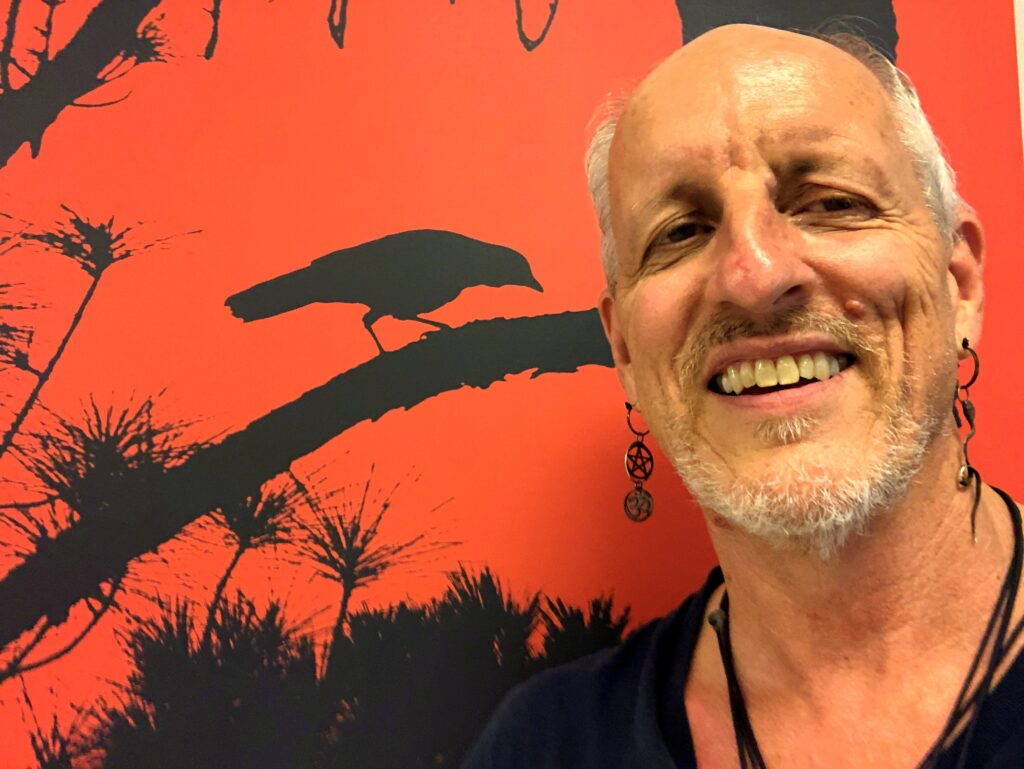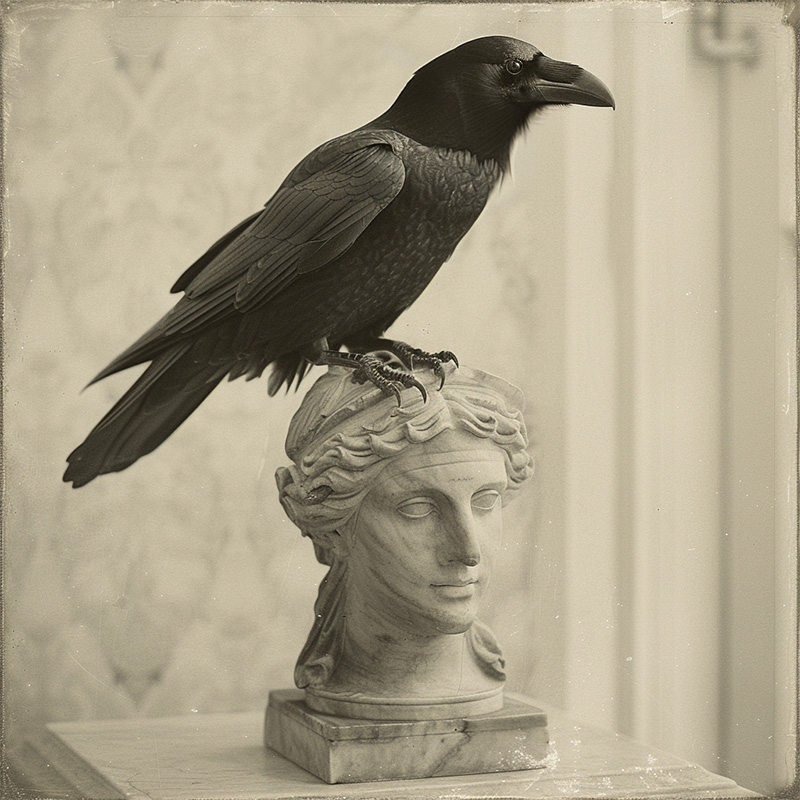We’ve always been fascinated by crows, and we’re not alone: their intelligence, behavior, and general spookiness has inspired humans from all over the planet to create fascinating folklore and enduring literature based around corvids. Modern science is catching up to the inner workings of corvid behavior, even examining their little brains with FMRI. Today’s guest is even more fascinated than we are, and we’re excited to learn from him!
Watch our interview with Rick about crow folklore here:
Or listen now:
About the Guest: Rick de Yampert
Rick de Yampert is a freelance writer, musician, artist and lecturer. He has been following a Pagan spiritual path since the early 1990s. His book Crows and Ravens: Mystery, Myth, and Magic of Sacred Corvids was released by Llewellyn in March 2024. The book, both a practical guide to magic, and a collection of crow folklore and raven myths, is available through Llewellyn, Amazon, or at your local pagan bookstore.
Prior to freelancing, Rick was the arts and entertainment writer at the Daytona Beach News-Journal, a daily newspaper, for 23 years. He has interviewed such creators as Kurt Vonnegut, Yoko Ono, Ray Manzarek of the Doors, Janet Jackson, Shirley MacLaine and many others. As a professional musician, Rick plays sitar, Native American flutes, djembe (African hand drum), tongue drums and guitar. He has performed at art festivals, cafes, yoga sessions and sacred events throughout Central Florida. Searching YouTube for his name yields a wide variety of live musical performances. Rick and his girlfriend Michelle Davidson, who plays crystal bowls, tongue drums and bass, perform as the music duo Wandering Spiral. We hope to interview Michelle on Homespun Haints soon, as she’s a psychic medium who authored a book about Florida’s haunted hotels.
As a lecturer, Rick presents programs on various spiritual and metaphysical topics to Unitarian Universalist churches, Pagan gatherings, and other organizations and events. As an artist, Rick takes photos of crows and shapeshifts them into phantasmagoric, magical landscapes using various digital programs. He then has the images printed on canvas for sale. Find Rick’s art online at mistercrowart.com, check out his YouTube channel, or follow Rick on IG and FB.

How to tell a crow from a raven
Crow characteristics:
- smaller,
- gregarious, congregate in “murders,”
- bolder, and thus more likely to live in urban areas,
- they usually say “caw,” or occasionally “mrow,” “coo,” or “whoo.”
Whereas ravens tend towards the following characteristics:
- 20% larger than crows,
- shaggy throat feathers,
- a group is called a “conspiracy” of ravens,
- skittish around people, and thus more likely to live in wooded areas,
- invariably more like a writing desk,
- still is sitting on Athena,
- they usually say “gronk.”

Both crows and ravens have the uncanny ability to recognize human faces, and possibly individuals from other species as well. Even more disturbing, once they form an opinion about a person, they can spread that reputation to others of their species, and even to future generations. One’s corvid reputation can be positive or negative, and, much like in an RPG, has direct consequences. Crows will attack someone they’ve seen with a dead crow; they’ll sometimes bring gifts to or play games with someone they decide is friendly. They’re also both very deliberate thinkers, who excel at problem solving and environmental adaptations. After all, city crows adapted to building their nests with anti-bird spikes.
How to befriend a crow
Thanks to their bold and curious nature, if you don’t already have a reputation with your local crows, it is possible to cultivate a relationship with one or more of them. Here are some tips for doing so:
- Bring food! Set it out in a safe place for crows to explore. It’s best if they don’t see you putting it there at first, but after they’ve gotten used to eating in your yard, let them observe you bringing the food. Rick offers them popcorn, crackers, or tortilla chips.
- Provide a water dish or bird bath, for crows to drink from in winter, or moisturize the food you offer.
- Pay attention to their vocalizations: the different sounds, patterns, rhythms, and volumes all seem to mean something specific to the crows beyond their relevance in folklore and divination magic. Mimicking their vocalizations may have some value in befriending them, but might also backfire.
- Crows leave shiny objects for people they like; why not try turning this around, and gift the crows small, lightweight, shiny objects?
- Most of all, stillness and repetition are key. It’ll take the crows a while to trust you, and any erratic or threatening behavior on your part, even inadvertently, will extend that timeline.
- Diana’s plan is to put a mannequin in her yard wearing a photo of her face, with an outstretched handful of kibble and peanuts.

Why would you want to befriend a crow?
The few lucky humans who’ve managed to form a strong bond with wild crows portray the relationship as just as fulfilling as that with a pet cat or dog. Once you’ve befriended a crow, they’re nearly as clever as dogs, and trainable, too. Or possibly, crows are even more clever, but in different ways.
Crows in folklore
It doesn’t surprise us at all that crows feature prominently in several folklore traditions. Those who incur the wrath of these intelligent and ominous-looking creatures might associate them with death because of their intense hostility towards enemies. It doesn’t help that corvids feast on carrion, including human corpses. There are tales of corvids following armies into battle, even inciting violence by revealing an enemy’s location, just for a free human meat lunch in the wake.
The Morrígan, also known as the Phantom Queen, is a prominent figure in Irish mythology. The Morrígan is a goddess associated with war and fate, especially with foretelling doom and death in battle. She is often depicted as having the ability to shape-shift, and her manifestations include that of a crow or raven.
On the other hand, those who’ve witnessed the intelligence and loyalty of crows might visualize just how useful these bold birds could be. In Norse mythology, the god Odin has 2 crow familiars/spies: Huginn and Muninn. These names translate to “thought” and “memory.” According to the myths, Odin would send Huginn and Muninn out at dawn, and they would return at dinner-time to perch on his shoulders. They would whisper the news and information they gathered into his ears.
Crow and raven lore in divination
Rick told us there are Irish prophesies based on crow behavior dating back to the 17th century. Perhaps independently, ancient Tibetans also had a system of divination based on the vocalizations of crows as far back as 900 AD. Viking raiders would hang raven banners, or lines with small cloth flags depicting birds, before going off to plunder and pillage. A waving banner foretold success, but a still banner portended loss.
Would you befriend a crow?
Or have you already? Does your magical, religious, or occult practice involve ravens or crows in some way? Got any more cool crow facts or folklore to share? Head over to our Facebook group to discuss. Or, if you’ve got an especially spooky ghost story involving crows or ravens, submit it, and you could be featured on the next episode of Homespun Haints. We’re as curious as crows eating dog kibble from the hand of a mannequin with Diana’s face on it about your corvalicious experiences, that must’ve been a spooky day, for sure!
Header photo by Jesse van Vliet on Unsplash
